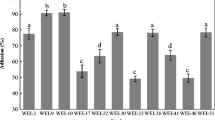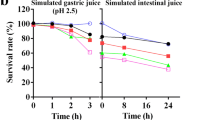Abstract
The present study aimed to isolate an optimal lactic acid bacterial strain from the feces of healthy giant pandas. The strain exhibited good stability at low pH and high bile salt concentrations, activity against pathogens relevant to pandas, and antibiotic susceptibility. In the current study, 25 isolates were obtained from de Man, Rogosa, and Sharpe agar. Two (E21 and G83) and eight (E1, E2, E16, E18, E21, E69, E70, and G83) isolates demonstrated good performance at pH 2.0 and bile 2% (w/v), respectively. Three isolates (G83, G88, and G90) possessed better antimicrobial effect on enterotoxigenic Escherichia coli CVCC196 (ETEC) than the rest. One isolate (G83) strongly affected Salmonella, whereas three (G83, G87, and G88) exhibited inhibitory activity against Staphylococcus aureus. All isolates were multi-drug resistant. These isolates were identified as Lactobacillus (5 isolates) and Enterococcus (20 isolates) by 16S rRNA sequencing. Virulence genes were detected in Enterococcus isolates. Isolate G83 was identified as Lactobacillus plantarum and was considered as the best probiotic candidate among all of the experimental isolates. This study provided necessary and important theoretical guidance for further experiments on G83 in vivo.

Similar content being viewed by others
References
Geier MS, Mikkelsen LL, Torok VA, Allison GE, Olnood CG, Boulianne M, Hughes RJ, Choct M (2010) Comparison of alternatives to in-feed antimicrobials for the prevention of clinical necrotic enteritis. J Appl Microbiol 109(4):1329–1338. https://doi.org/10.1111/j.1365-2672.2010.04758.x
Archambaud C, Nahori MA, Soubigou G, Bécavin C, Laval L, Lechat P, Smokvina T, Langella P, Lecuit M, Cossart P (2012) Impact of lactobacilli on orally acquired listeriosis. Proc Natl Acad Sci 109(41):16684–16689. https://doi.org/10.1073/pnas.1212809109
Yu Q, Yuan L, Deng J, Qian Y (2015) Lactobacillus protects the integrity of intestinal epithelial barrier damaged by pathogenic bacteria. Front Cell Infect Microbiol 5:26. https://doi.org/10.3389/fcimb.2015.00026
Zhou Z, Zhou X, Zhong Z, Wang C, Zhang H, Li D, He T, Li C, Liu X, Yuan H (2014) Investigation of antibacterial activity of Bacillus spp. isolated from the feces of Giant Panda and characterization of their antimicrobial gene distributions. World J Microbiol Biotechnol 30(12):3129–3136. https://doi.org/10.1007/s11274-014-1740-y
Wu C, Wu L, Zhang L, Gelbič I, Xu L, Guan X (2014) Characterization of eight Bacillus thuringiensis isolates originated from fecal samples of Fuzhou Zoo and Fuzhou Panda Center. J Asia Pac Entomol 17(3):395–397. https://doi.org/10.1016/j.aspen.2014.02.009
Chen F, Shuang L, Cheng L, Shuang M, Li Z, Qi W (2012) Isolation, identification and cellulase production of a cellulolytic bacterium from intestines of giant panda (in Chinese). Acta Microbiol Sin 52(9):1113–1121 (樊程, 李双江, 李成磊, 马双, 邹立扣, 吴琦 (2012) 大熊猫肠道纤维素分解菌的分离鉴定及产酶性质. 微生物学报 52 (9):1113-1121)
Peng Z, Dong Z, Qiang W, Niu L, Ni X, Zou F, Yang M, Hao S, Yi Z, Qian L (2016) Decreased microbial diversity and Lactobacillus group in the intestine of geriatric giant pandas (Ailuropoda melanoleuca). World J Microbiol Biotechnol 32(5):79. https://doi.org/10.1007/s11274-016-2034-3
Chen X, Yin M, Wang X, Pu Z, Ma Y, Chen Z (2015). Isolation and preliminary identification of intestinal pathogens of captive giant panda (In Chinese). J Mianyang Normal Univ (2):1–7. (陈希文, 尹苗, 王雄清, 蒲中慧, 马缨, 陈紫娟 (2015) 圈养大熊猫肠道致病菌的分离与初步鉴定. 绵阳师范学院学报 (2):1–7). https://doi.org/10.3969/j.issn.1672-612x.2015.02.001
Fei S, Jing L, Dan X, Wan W, Geng G, Ning F, Shui Y (2002) Pathogens of intestinal disease in giant panda (in Chinese). J Economic Animal 6(2):20–23 (孙飞龙, 刘敬贤, 席丹, 王万云, 高更更, 冯宁, 杨水云 (2002) 大熊猫肠道疾病致病菌. 经济动物学报 6 (2):20-23). https://doi.org/10.3969/j.issn.1007-7448.2002.02.006
Fontana C, Cocconcelli PS, Vignolo G, Saavedra L (2015) Occurrence of antilisterial structural bacteriocins genes in meat borne lactic acid bacteria. Food Control 47:53–59. https://doi.org/10.1016/j.foodcont.2014.06.021
Ghosh K, Ray M, Adak A, Halder SK, Das A, Jana A, Parua S, Vágvölgyi C, Mohapatra PKD, Pati BR (2015) Role of probiotic Lactobacillus fermentum KKL1 in the preparation of a rice based fermented beverage. Bioresour Technol 188:161–168. https://doi.org/10.1016/j.biortech.2015.01.130
Cockerill FR (2013) Performance standards for antimicrobial susceptibility testing : twenty-first informational supplement. Clinical and Laboratory Standards Institute
Eaton TJ, Gasson MJ (2001) Molecular screening of Enterococcus virulence determinants and potential for genetic exchange between food and medical isolates. Appl Environ Microbiol 67(4):1628–1635. https://doi.org/10.1128/AEM.67.4.1628-1635.2001
Bellomo G, Mangiagle A, Nicastro L, Frigerio G (1980) A controlled double-blind study of SF68 strain as a new biological preparation for the treatment of diarrhoea in pediatrics. Curr Ther Res Clin 28(6):927–936
Shankar V, Baghdayan AS, Huycke MM, Lindahl G, Gilmore MS (1999) Infection-derived Enterococcus faecalis strains are enriched in esp, a gene encoding a novel surface protein. Infect Immun 67(1):193–200
Su YA, Sulavik MC, He P, Makinen KK, Makinen PL, Fiedler S, Wirth R, Clewell DB (1991) Nucleotide sequence of the gelatinase gene (gelE) from Enterococcus faecalis subsp. liquefaciens. Infect Immun 59(1):415–420
Gilmore MS, Segarra RA, Booth MC, Bogie CP, Hall LR, Clewell DB (1994) Genetic structure of the Enterococcus faecalis plasmid pAD1-encoded cytolytic toxin system and its relationship to lantibiotic determinants. J Bacteriol 176(23):7335–7344. https://doi.org/10.1128/jb.176.23.7335-7344.1994
Mannu L, Paba A, Daga E, Comunian R, Zanetti S, Duprè I, Sechi LA (2003) Comparison of the incidence of virulence determinants and antibiotic resistance between Enterococcus faecium strains of dairy, animal and clinical origin. Int J Food Microbiol 88(2):291–304. https://doi.org/10.1016/S0168-1605(03)00191-0
Barbavidal E, Castillejos L, Lópezcolom P, Rivero UM, Moreno Muñoz JA, Martínorúe SM (2017) Evaluation of the probiotic strain Bifidobacterium longum subsp. Infantis CECT 7210 capacities to improve health status and fight digestive pathogens in a piglet model. Front Microbiol 8:533. https://doi.org/10.3389/fmicb.2017.00533
Nishida S, Ishii M, Nishiyama Y, Abe S, Ono Y, Sekimizu K (2017) Lactobacillus paraplantarum 11-1 isolated from rice bran pickles activated innate immunity and improved survival in a silkworm bacterial infection model. Front Microbiol 8:436. https://doi.org/10.3389/fmicb.2017.00436
Wu Y, Wang Y, Zhou H, Wang B, Sun Q, Fu A, Wang Y, Wang Y, Xu X, Li W (2017) Probiotic Bacillus amyloliquefaciens SC06 induces autophagy to protect against pathogens in macrophages. Front Microbiol 8:469. https://doi.org/10.3389/fmicb.2017.00469
Gareau MG, Sherman PM, Walker WA (2010) Probiotics and the gut microbiota in intestinal health and disease. Nat Rev Gastroenterol Hepatol 7(9):503–514. https://doi.org/10.1038/nrgastro.2010.117
Yadav R, Puniya AK, Shukla P (2016) Probiotic properties of Lactobacillus plantarum RYPR1 from an indigenous fermented beverage Raabadi. Front Microbiol 7:1683. https://doi.org/10.3389/fmicb.2016.01683
Havenaar R, Brink BT, Veld JHJHI (1992) Selection of strains for probiotic use. Springer Netherlands:209–224. https://doi.org/10.1007/978-94-011-2364-8_9
Klopper KB, Deane SM, Lmt D (2017) Aciduric strains of Lactobacillus reuteri and Lactobacillus rhamnosus, isolated from human feces, have strong adhesion and aggregation properties. Probiotics Antimicro 2:1–9. https://doi.org/10.1007/s12602-017-9307-5
Beasley SS, Manninen TJK, Saris PEJ (2006) Lactic acid bacteria isolated from canine faeces. J Appl Microbiol 101(1):131–138. https://doi.org/10.1111/j.1365-2672.2006.02884.x
Blazenka K, Jagoda Š, Jasna B, Krešimir G, Jadranka F, Carlo I, Francesco C (2008) Characterization of the three selected probiotic strains for the application in food industry. World J Microbiol Biotechnol 24(5):699–707
Verso LL, Lessard M, Talbot G, Fernandez B, Fliss I (2017) Isolation and selection of potential probiotic bacteria from the pig gastrointestinal tract. Probiotics Antimicro 5:1–14. https://doi.org/10.1007/s12602-017-9309-3
Sharma P, Tomar SK, Sangwan V, Goswami P, Singh R (2016) Antibiotic resistance of Lactobacillus sp. isolated from commercial probiotic preparations. J Food Saf 36(1):38–51. https://doi.org/10.1111/jfs.12211
Egervärn M, Lindmark H, Olsson J, Roos S (2010) Transferability of a tetracycline resistance gene from probiotic Lactobacillus reuteri to bacteria in the gastrointestinal tract of humans. Anton Leeuw Int J G 97(2):189–200. https://doi.org/10.1007/s10482-009-9401-0
Korhonen JM, Hoek AHAMV, Saarela M, Huys G, Tosi L, Mayrhofer S, Wright AV (2010) Antimicrobial susceptibility of Lactobacillus rhamnosus. Benefic Microbes 1(1):75–80. https://doi.org/10.3920/BM2009.0002
Colombo M, Castilho NP, Todorov SD, Nero LA (2017) Beneficial and safety properties of a Corynebacterium vitaeruminis strain isolated from the cow rumen. Probiotics Antimicro 9(2):157–162. https://doi.org/10.1007/s12602-017-9263-0
Barton MD (2000) Antibiotics or probiotics: reducing antibiotic resistance. J Magn Reson Imaging 13:352–355
Franz CMAP, Melanie H, Hikmate A, Wilhelm H, Antonio G (2011) Enterococci as probiotics and their implications in food safety. Int J Food Microbiol 151(2):125–140. https://doi.org/10.1016/j.ijfoodmicro.2011.08.014
Kreuzer S, Machnowska P, Aßmus J, Sieber M, Pieper R, Schmidt MF, Brockmann GA, Scharek-Tedin L, Johne R (2012) Feeding of the probiotic bacterium Enterococcus faecium NCIMB 10415 differentially affects shedding of enteric viruses in pigs. Vet Res 43(1):95–96. https://doi.org/10.1186/1297-9716-43-58
Hunt CP (1998) The emergence of enterococci as a cause of nosocomial infection. Brit J Biomed Sci 55(2):149–156
Jett BD, Huycke MM, Gilmore MS (1994) Virulence of enterococci. Clin Microbiol Rev 7(4):462–478. https://doi.org/10.1128/CMR.7.4.462
Lee K, Lee M, Lee Y (2008) Safety assessment of commercial Enterococcus probiotics in Korea. J Microbiol Biotechnol 18(5):942–945
Funding
The present study was supported by the National Natural Science Foundation of China (31672318) and the Funded Project of Chengdu Giant Panda Breeding Research Foundation (CPF2014-15, CPF2015-06).
Author information
Authors and Affiliations
Author notes
Xueqin Ni, Qiang Wang and Zhirong Peng are joint first authors.
Corresponding author
Ethics declarations
Conflict of Interest
The authors declare that they have no conflict of interest.
Rights and permissions
About this article
Cite this article
Liu, Q., Ni, X., Wang, Q. et al. Investigation of Lactic Acid Bacteria Isolated from Giant Panda Feces for Potential Probiotics In Vitro. Probiotics & Antimicro. Prot. 11, 85–91 (2019). https://doi.org/10.1007/s12602-017-9381-8
Published:
Issue Date:
DOI: https://doi.org/10.1007/s12602-017-9381-8




